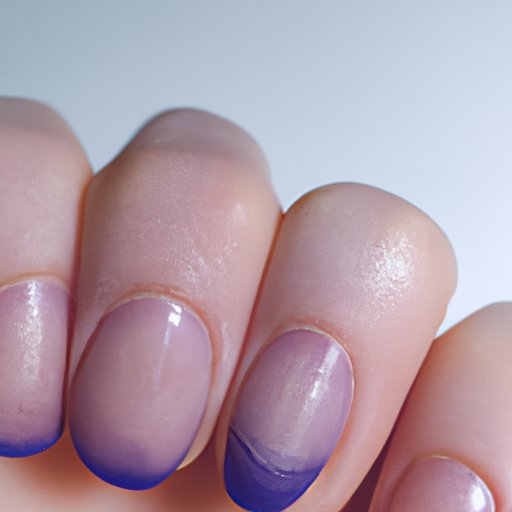Introduction
Nail beds are the underlying structures that support the growth of your fingernails and toenails. They are made up of skin, blood vessels, and nerve endings, and they provide a protective cushion for the nail plate. Understanding what nail beds are and how to properly care for them is essential for maintaining healthy nails. In this article, we will explore the anatomy of nail beds, how to take care of them, common conditions, and different types of nail beds.
Understanding Healthy Nail Beds and How to Take Care of Them
Taking proper care of your nail beds is essential for keeping them healthy and strong. Basic nail care tips include washing your hands regularly with soap and water, using hand sanitizer when necessary, and wearing gloves when doing any kind of cleaning or gardening. Additionally, you should avoid biting or picking at your nails, as this can damage the nail bed and lead to infection.
In addition to basic nail care, it’s important to maintain a proper diet and supplement your diet with the right nutrients for healthy nail beds. Vitamins A, C, D, E, and K are all essential for healthy nails, as well as minerals such as zinc, iron, and calcium. Eating a balanced diet full of fresh fruits and vegetables will help ensure that you’re getting all the essential vitamins and minerals for healthy nails.

Common Conditions of the Nail Bed and Treatment Options
The most common condition affecting the nail bed is a fungal infection. Fungal infections can be caused by dampness in the environment, poor hygiene, or even contact with an infected person or animal. Symptoms of a fungal infection include discoloration, thickening, crumbling, and splitting of the nails. Treatment options include antifungal medications, laser therapy, and topical creams.
Another common condition of the nail bed is dryness. Dryness can be caused by exposure to harsh chemicals, frequent use of nail polish remover, or simply not drinking enough water. Symptoms of dryness include brittleness, splitting, and cracking of the nails. Treatment options include moisturizing with lotion or oil, avoiding harsh chemicals, and taking biotin supplements.
There are also other conditions that can affect the nail bed, such as psoriasis, eczema, and traumatic injuries. It is important to consult with a doctor if you experience any symptoms of these conditions, as they can be serious and require medical attention.

DIY Nail Care Tips for Keeping Your Nail Beds Healthy
Proper hygiene is essential for keeping your nail beds healthy. Wash your hands regularly with soap and water and use hand sanitizer when necessary. Avoid biting or picking at your nails, as this can cause damage to the nail bed. Wear gloves when doing any kind of cleaning or gardening.
Moisturizing your nails is also important for keeping them healthy. Use a moisturizer or oil on your nails and cuticles every day to keep them hydrated. You can also add a few drops of essential oils such as lavender or tea tree oil to your moisturizer for added benefits.
Exfoliating your nails is another way to keep them healthy. Use a scrub brush or pumice stone to gently exfoliate the nail bed once or twice a week. This will help remove dead skin cells and promote healthy nail growth.

Supplementing Your Nail Care with Nutrients for Healthy Nail Beds
Vitamins and minerals are essential for healthy nail beds. Vitamins A, C, D, E, and K are all important for healthy nails, as well as minerals such as zinc, iron, and calcium. Eating foods such as dark leafy greens, nuts and seeds, salmon, and avocado will help ensure that you’re getting all the essential vitamins and minerals for healthy nails.
You can also take supplements to supplement your diet. Biotin is a vitamin that helps strengthen and nourish the nails, and omega-3 fatty acids can help reduce inflammation. Additionally, collagen supplements can help improve the elasticity of the nails and promote healthy nail growth.
Different Types of Nail Beds and Their Characteristics
There are three main types of nail beds: normal, thin, and thick. Normal nail beds are healthy and have a pinkish hue. Thin nail beds are thinner than normal and may have ridges or be prone to splitting. Thick nail beds are thicker than normal and may be more prone to fungal infections.
Conclusion
Nail beds are the structures that support the growth of your fingernails and toenails. Proper care and maintenance of your nail beds is essential for keeping them healthy and strong. This includes washing your hands regularly, eating a balanced diet, and supplementing your diet with the right vitamins and minerals. Additionally, there are a variety of DIY nail care tips and treatments available for common conditions of the nail bed. Finally, there are three main types of nail beds: normal, thin, and thick.
By understanding what nail beds are and how to properly take care of them, you can ensure that your nails stay healthy and strong. With the right knowledge and care, you can keep your nails looking great for years to come.


